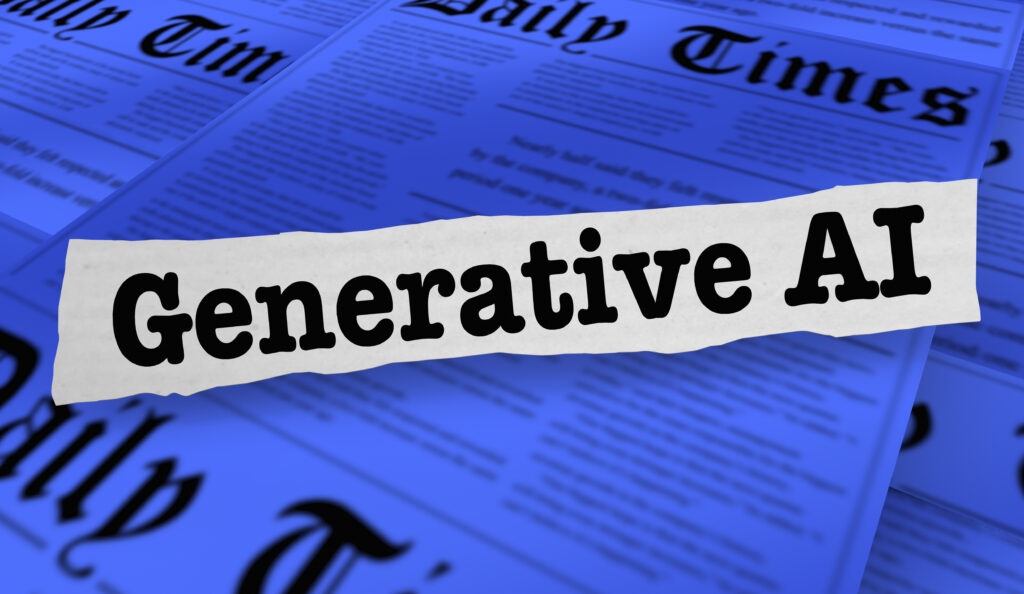Many creative professionals have heard rumblings of a seismic shift underway. Generative AI models are poised to disrupt the creative industry, from visual arts to music, film, and beyond. Systems like Runway’s Gen-1, Google’s AudioML, and Diffusion can already generate high-quality digital art, music, and video with little or no human input. What does this mean for the future of human creativity? Will AI become an indispensable creative partner, or replace artists entirely? The implications are profound. In this article, we dive into the state of generative AI across creative sectors and explore what’s next for humans and machines in artistic expression. Though uncertainties abound, one thing is clear – the creative field is about to change.
An Introduction to Generative AI

Generative AI leverages machine learning models to generate new content like images, music, text, and videos. These models are trained on thousands of examples to identify patterns and learn the underlying structure of a domain. They can then generate completely new, synthetic content in the same style.
Image Generation
- Models like Runway’s Gen-1 generate high-quality digital art after being trained on datasets of images. The AI learns artistic styles, textures, compositions, and other attributes to create its own unique images. Some models can generate images from text descriptions or even recreate images in a particular artistic style.
Music and Audio Generation
- AI systems like Google’s Magenta and Anthropic’s Claude can generate short musical compositions and simple instrumentals. They are trained on thousands of songs and scores to learn musical styles, rhythms, melodies, and harmonies. The generated music may not be ready for commercial release but it shows the potential for AI to become a creative collaborator.
Video Generation
- Recent models have demonstrated the ability to generate short video clips, though quality and cohesiveness still need improvement. Models like Riffusion learn attributes of video like objects, scenes, sounds, and camera motion. They can then generate short video clips in a particular style, though longer or more complex videos remain challenging.
Generative AI has made exciting progress but still struggles with key aspects of human creativity like emotional intelligence, life experiences, and an intrinsic drive for self-expression. While AI may become a tool for artists and creators, human imagination and ingenuity remain irreplaceable. With collaboration, humans and AI can achieve creative heights neither could alone.
Generative AI’s Impact on Visual Arts
Democratization of Creativity
- Generative AI models can generate a large volume of images, enabling more people to create and share digital art. Tools like Runway’s ML and Anthropic’s Constitutional AI make it easy for non-experts to generate images with the click of a button. This democratization of creativity could inspire new artistic movements and styles as people from all backgrounds explore AI as a new creative medium.
Augmenting Human Creativity
- Rather than replacing human artists, generative AI can augment and enhance human creativity. AI tools can help generate initial ideas that artists refine and build upon. They can also help artists explore new styles by generating images in different genres, subjects, or color palettes. This human-AI collaboration could push the boundaries of art in exciting new directions. However, it requires that artists have a strong understanding of how these AI systems work and their limitations to use them effectively as creative tools.
Addressing Bias and Fairness
- There are also risks and challenges to consider with generative AI in visual arts. The data used to train these models may reflect and even amplify the biases of human artists. This could negatively impact minority groups and underrepresented communities in the art world. Researchers are working to develop techniques to identify and mitigate bias in AI models. They are also exploring how to increase diversity in training data to build AI that generates art in a fair, unbiased manner.
With proper safeguards and oversight in place, generative AI could positively transform visual arts by providing new creative tools, enabling broader participation, and pushing the boundaries of human expression. But we must be proactive and thoughtful about how we develop and apply this technology to ensure it is fair, transparent, and aligned with human values. The future of AI in arts depends on building models that enhance and empower human artists rather than replace them.
The Effect of Generative AI on Music Production
Generative AI has the potential to significantly impact the music industry. As models become more sophisticated, they may augment or replace certain roles like songwriting, composing, and mixing. However, human artists, producers, and engineers will still play an essential part in the creative process.
AI-Generated Music
- Systems like Google’s AudioML and Anthropic’s Constitutional AI can generate simple melodies, harmonies, and rhythms. While currently basic, continual progress may enable AI to craft complete pop songs or film scores. Such systems could generate a large volume of music for commercial use. However, human composers would likely still be needed for more complex, emotive pieces.
Augmenting the Creative Process
- Rather than replacing humans, AI may primarily augment music production. For example, AI could generate multiple melodic or rhythmic options for composers to choose from or create a basic song structure for humans to build upon. Systems could also analyze a composer’s previous work to suggest a new chord progression or melody in a similar style. Engineers and producers could use AI to experiment with different mixes or mastering options. However, human judgment and oversight would remain essential to crafting music with heart and soul.
Challenges and Considerations
- There are also challenges to address regarding data bias, loss of human jobs, and ethical concerns. The music industry must ensure that AI systems are developed and applied responsibly by including human artists in the process and considering how to retrain workers whose jobs are affected. If used properly, Generative AI may open up new creative opportunities and help democratize music production, but human ingenuity and emotion are still vital. Overall, a symbiotic relationship between humans and AI in the music industry seems the most likely and positive path forward.
Generative AI in Filmmaking and Animation
Generative AI has the potential to transform filmmaking and animation. AI models can generate synthetic images, video, speech, music, and other media that could be incorporated into films and animation. Some companies are developing AI that generates story ideas, characters, dialogue, and even entire film scripts.
Synthetic Media Generation
- AI models like Google’s DeepDream and Nvidia’s GauGAN can create synthetic landscapes, objects, and characters. These could provide source material for animation and visual effects. Models that generate photorealistic human faces and speech, like Anthropic’s Constitutional AI, may enable new types of characters. However, synthetic media also raises concerns about manipulation and misinformation that creators will need to consider.
Automated Creativity
- Some companies are developing AI that generates creative ideas and stories. Anthropic’s Claude model can suggest dialogue, characters, and plot points. Similarly, the AI startup Anthropic has created software called Claude that generates short stories, while the Allen Institute for Artificial Intelligence developed a model called Aristo that can craft simple fictional stories. These tools could provide inspiration and raw material for films, although human creators will still shape the final creative work.
Enhancing Human Creativity
- Rather than replacing human creators, AI may primarily enhance and complement human creativity. Generative AI could suggest ideas, variations, and options that human writers, directors, and animators then build upon and improve. AI could also take on specific, limited creative tasks, like basic animation, video editing, and other technical roles. This human-AI collaboration may achieve better results than either alone.
With continued progress in generative AI and human-AI collaboration, films and animation could become more creative, personalized, culturally diverse, and globally representative. However, creators will need to consider the responsible development and application of these AI technologies. Overall, generative AI may open up new avenues for artistic expression if wielded judiciously and for the benefit of audiences and society.
The Future of Creativity and Generative AI in Creative Industries
Generative AI has the potential to significantly impact human creativity and artistic expression. As AI systems become more advanced at generating digital art, music, stories, and videos, questions arise about how human artists will adapt and what role they will play.
AI as a Collaborator
- Rather than replacing human artists, AI may primarily serve as a collaborator. Generative models can help with repetitive and mundane tasks, freeing artists to focus on higher-level creative work. For example, an AI could generate a piece of music or a digital artwork which the human artist then modifies and improves. This type of human-AI collaboration may produce even more creative results than either could alone.
New Creative Opportunities
- Generative AI also opens up new creative opportunities for human artists. They can experiment with AI systems to discover unexpected and serendipitous results, using those as inspiration for new works. Artists may also choose to incorporate AI-generated elements directly into their creations, curating and arranging them to achieve a particular artistic vision. These new ways of creating and expressing oneself creatively point to an optimistic future where AI amplifies and expands human creativity rather than diminishing it.
Responsible Development of AI
- However, the future of creativity and AI will depend on the responsible development of generative models. If not designed ethically, AI could be used to generate synthetic media for malicious purposes like fraud, scams, and misinformation. Models may also reflect and amplify the biases of their training data, producing results that marginalize underrepresented groups.
Developing AI safely and for the benefit of humanity will require ongoing collaboration between researchers, artists, and the public. With open discussion and by upholding key values like inclusiveness, diversity, and transparency, generative AI can achieve its potential as a tool for cultivating and augmenting human creativity. Overall, the future looks bright for human artistry and expression with AI as a partner, provided we commit to using this technology responsibly and for good.
Conclusion
As generative AI continues to advance, we must thoughtfully consider its role in creative industries. Whilst these tools provide exciting possibilities, we should ensure human creativity and artistic integrity remain at the core. By establishing ethical frameworks and understanding how to best collaborate with AI, we can harness its potential to augment our creative capacities, not replace them. This begins by having open and constructive conversations about the future we want to build. If navigated wisely, humans and machines can inspire each other in groundbreaking new ways, driving innovation whilst respecting what makes us most human: our innate need to create and connect.
More Stories
Samsung’s AI Power Play: Perplexity Partnership Signals Shift from Google
Samsung is poised to redefine AI in its Galaxy smartphones through a bold strategic move. It has partnered with Perplexity AI, an innovative U.S.-based startup. This signals a possible shift away from Google’s AI ecosystem. As a result, Samsung may integrate Perplexity’s advanced assistant into its devices.
Roblox Farming Craze Fuels Surging App Store Economy
As you dive into the dynamic world of digital economies, one phenomenon stands out: the Roblox farming craze. This surge,...
DeepSeek R1-0528 Powers Open-Source AI Challenge to OpenAI and Google
In the fast-changing world of artificial intelligence, DeepSeek's new model, DeepSeek-R1-0528, stands out as a strong competitor. It challenges major...
EastWest Bank Embraces Temenos SaaS to Propel Digital Transformation
EastWest Bank leads digital transformation in financial services through its new partnership with Temenos. The collaboration uses Temenos’ advanced Software-as-a-Service (SaaS) solution.
Apex Group Taps Tom Bennett to Spearhead Global Fintech Strategy
Apex Group Ltd. has strategically appointed Tom Bennett as Global Head of Fintech. This pivotal role highlights Apex Group’s commitment to advancing its digital capabilities across private markets, capital markets, and digital assets.
Operator 2.0: OpenAI’s o3 Model Elevates Autonomous AI Agents
OpenAI’s latest advancement marks a new milestone with the introduction of Operator 2.0, powered by the cutting-edge o3 model


